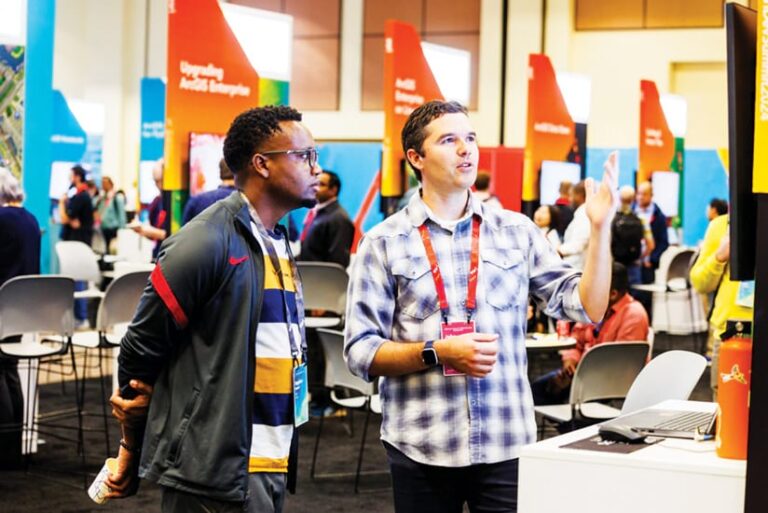While showing developers and partners dozens of new ways to extend and build on GIS technology, Esri’s annual developer-focused summit also provided attendees with myriad opportunities to collaborate and network.
Held in Palm Springs, California, March 12–15, the 19th annual Esri Developer Summit (DevSummit) represented the largest gathering of geospatial technology developers in the world, with nearly 4,000 in-person and virtual attendees from more than 50 countries. Developers were given the once-a-year opportunity to learn new techniques and where Esri technology is going, brush up on skills, and connect with fellow GIS developers and enthusiasts.

One event highlight was the introduction of new web components that are part of ArcGIS Maps SDK for JavaScript, which brings prebuilt ArcGIS experiences (encapsulated in web components) into apps. By writing just a few lines of code, users can now leverage many of the same capabilities as other Esri apps, such as creating charts, accessing attributes in vector tile layers, employing interactive editing constraints, and taking advantage of 3D tiles support.
“Web components are new to JavaScript Maps SDK, and they encapsulate both functionality and styling in a standards-based way,” said David Cardella, product manager for the Esri developer technology group. He described web components as a set of building blocks for assembling solutions and apps across multiple platforms.
“They’re native to the browser, so you don’t need to worry about compatibility challenges,” he said. “And they simplify your development experience by having you write less code.”
The summit also showcased new features for ArcGIS Maps SDKs for Native Apps, including support for custom feeds to power real-time situational awareness experiences and smart forms to streamline attribute editing. Attendees were introduced to the new ArcGIS Maps SDK for Flutter (in beta), which provides developers with a new way to create cross-platform native mobile apps with ArcGIS capabilities. And according to Cardella, the Native Maps SDKs continue to be built on a common C++ core, maximizing performance and consistency both online and offline; in 2D and 3D; and on mobile, desktop, and embedded devices.

Speakers also discussed Esri’s initiatives to help developers easily incorporate Esri resources into open-source apps. For example, Esri developers regularly share open-source projects via GitHub to enable developers and partners to port Esri capabilities across the web. Another example is Esri Geoportal Server, a free, open-source, standards-based metadata catalog management app that enables users to discover and employ geospatial and nongeospatial resources.
Keynote presentations at DevSummit included the following:
- Liz Fulton, the digital and geospatial services director of vegetation management company Asplundh, described how the organization’s field staff use tailored GIS apps to optimize their work.
- Justin Madex—spatial services manager for the Australian state of Victoria’s Department of Environment, Land, Water and Planning—explained how the department empowers its planners with web-based 3D spatial analysis tools.
- Michael Healander, cofounder, president, and CEO of Esri partner Airspace Link, showed how the company uses location services in its drone flight management solutions.
Other summit highlights included presentations on how generative AI and ArcGIS can integrate to provide trustworthy, innovative functionality. Attendees also got a tour of the new ArcGIS Well-Architected Framework and Architecture Center, an online resource to help organizations make informed decisions when implementing or using ArcGIS as an enterprise system.
Additionally, there were demonstrations on how ArcGIS Maps SDKs for Game Engines can help make scenes and data come to life, as well as on how integrating Calcite Design System components and React can help developers craft a superior user experience.

Attendees were introduced to new {arcgis} R bridge functions, such as an open-source package that facilitates interaction with ArcGIS location services from the R programming language. They also learned about the updated ArcGIS Basemaps styles service, which has new map styles such as ArcGIS Outdoor and ArcGIS Editor for OpenStreetMap navigation. In addition, there were sessions on how advances in ArcGIS Indoors and ArcGIS IPS can improve indoor asset and space management, safety, and security, as well as the occupant experience.
As DevSummit attendees learned more about client APIs, new developments in spatial analytics, and tools for extending and automating the entire ArcGIS system, they also shared their ideas, opinions, and projects with Esri employees. This is a reciprocal relationship that continually helps Esri refine and advance its own technological capabilities.
“I want you to share what you are doing so we learn from each other,” advised Esri president Jack Dangermond.
Get more information on the summit, including links to Plenary Session and presentation videos, at the Esri Developer Summit web page.

